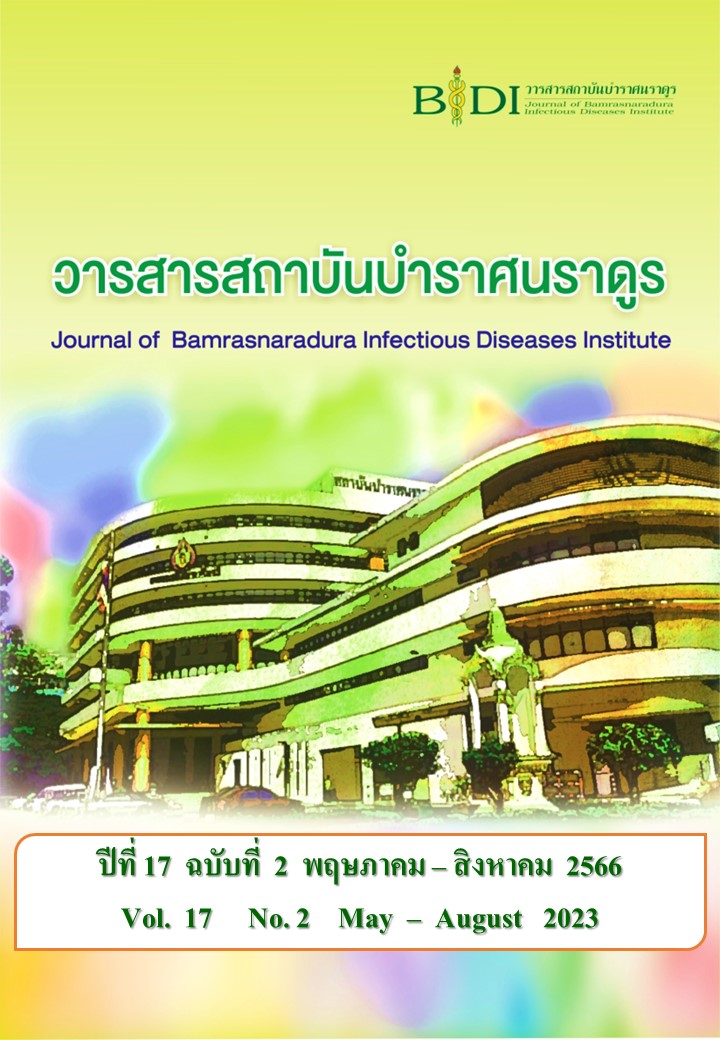ความสัมพันธ์ระหว่างความร่วมมือในการใช้ยาจากข้อคำถามเดี่ยว และความล้มเหลวต่อการรักษาทางไวรัสในผู้ป่วยติดเชื้อเอชไอวี
Main Article Content
บทคัดย่อ
ความร่วมมือในการใช้ยาต้านเอชไอวีมีผลต่อความสำเร็จของการรักษาเอชไอวี การรายงานความร่วมมือในการใช้ยาด้วยตัวผู้ป่วยเองเป็นที่นิยม เนื่องจากประหยัดและมีความสะดวก การศึกษานี้เป็นการศึกษาเชิงวิเคราะห์ย้อนหลังจากผลไปหาเหตุแบบจับคู่ เพื่อศึกษาความสัมพันธ์ระหว่างความร่วมมือในการใช้ยาต้านเอชไอวีที่ได้จากการใช้ข้อคำถามเดี่ยวและความล้มเหลวต่อการรักษาทางไวรัสในผู้ป่วยติดเชื้อเอชไอวี โดยทำการศึกษาผู้ป่วยติดเชื้อเอชไอวีที่มีอายุ 18 ปีขึ้นไป จำนวน 122 คน โดยแบ่งผู้ป่วยออกเป็น 2 กลุ่ม ได้แก่ กลุ่มศึกษา คือ ผู้ป่วยติดเชื้อเอชไอวีที่มีความล้มเหลวต่อการรักษาทางไวรัส และกลุ่มควบคุม คือ ผู้ป่วยติดเชื้อเอชไอวีที่ไม่มีความล้มเหลวต่อการรักษาทางไวรัส โดยจับคู่กลุ่มศึกษาและกลุ่มควบคุมในอัตราส่วน 1:1 ด้วยเพศและสูตรยา และเก็บข้อมูลความร่วมมือในการใช้ยาจากฐานข้อมูลของโรงพยาบาล ผลการศึกษาพบว่าผู้ป่วยติดเชื้อเอชไอวีทั้ง 2 กลุ่ม จำนวนกลุ่มละ 61 คน มีความร่วมมือในการใช้ยาที่ดี ร้อยละ 35.94 และ 64.06 ตามลำดับ และพบว่าผู้ป่วยติดเชื้อเอชไอวีที่มีความร่วมมือในการใช้ยาที่ไม่ดี มีความเสี่ยงในการเกิดความล้มเหลวต่อการรักษาทางไวรัสมากกว่าผู้ป่วยติดเชื้อเอชไอวีที่มีความร่วมมือในการใช้ยาที่ดีอย่างมีนัยสำคัญทางสถิติ (OR=10.03; 95%Cl= 2.325-43.258; p-value = 0.002) ความร่วมมือในการใช้ยาต้านเอชไอวีได้จากการใช้ข้อคำถามเดี่ยวมีความสัมพันธ์กับความล้มเหลวต่อการรักษาทางไวรัสอย่างมีนัยสำคัญทางสถิติ ดังนั้นการใช้ข้อคำถามเดี่ยวในการประเมินความร่วมมือในการใช้ยาเพียงอย่างเดียว อาจเป็นเครื่องมือที่ช่วยประเมินความร่วมมือในการใช้ยาของผู้ป่วยติดเชื้อเอชไอวีในบริบทที่มีข้อจำกัดด้านเวลาในการดูแลผู้ป่วย
Article Details
เอกสารอ้างอิง
Panel on Antiretroviral Guidelines for Adults and Adolescents. Guidelines for the Use of Antiretroviral Agents in Adults and Adolescents Living with HIV [Internet] 2018. [cited 2018 Feb 1]. Available from: http://www.aidsinfo.nih.gov/ContentFiles/Adultand AdolescentGL.pdf
Steel G, Nwokike J, Joshi M. Development of a multi-method tool to measure ART adherence in resource-constrained settings: The South Africa experience. Submitted to the U.S. agency for international development by the rational pharmaceutical management plus program. Arlington, VA: Management Sciences for Health; 2007. P. 6-9.
Stirratt MJ, Dunbar-Jacob J, Crane HM, Simoni JM, Czajkowski S, Hilliard ME, et al. Self-report measures of medication adherence behavior: recommendations on optimal use. Transl Behav Med 2015 Dec; 5(4): 470-82. doi: 10.1007/s13142-015-0315-2. PMID: 26622919.
Machtinger EL, Bangsberg DR. Adherence to HIV antiretroviral therapy [Internet]. 2006 [cited 2018 Aug 7]. Available from: http://hivinsite.ucsf.edu/InSite?page=kb-03-02-09#S1X
Segeral O, Madec Y, Ban B, Ouk V, Hak CR, Le Tiec C, et al. Simplified assessment of antiretroviral adherence and prediction of virological efficacy in HIV-infected patients in Cambodia. AIDS Res Treat 2010;2010:142076. doi:10.1155/2010/142076. PMID: 21490902
Goldman JD, Cantrell RA, Mulenga LB, Tambatamba BC, Reid SE, Levy JW, et al. Simple adherence assessments to predict virologic failure among HIV-infected adults with discordant immunologic and clinical responses to antiretroviral therapy. AIDS Res Hum Retroviruses 2008 Aug;24(8):1031-5. doi: 10.1089/aid.2008.0035. PMID: 18724803.
Arnsten JH, Demas PA, Farzadegan H, Grant RW, Gourevitch MN, Chang CJ, et al. Antiretroviral therapy adherence and viral suppression in HIV-infected drug users: comparison of self-report and electronic monitoring. Clin Infect Dis 2001 Oct 15; 33(8):1417-23. doi: 10.1086/323201. PMID: 11550118.
Haubrich RH, Little SJ, Currier JS, Forthal DN, Kemper CA, Beall GN, et al. The value of patient-reported adherence to antiretroviral therapy in predicting virologic and immunologic response. California Collaborative Treatment Group. AIDS 1999 Jun 18;13(9):1099-107. doi: 10.1097/00002030-199906180-00014. PMID: 10397541.
Glass TR, Sterne JA, Schneider MP, De Geest S, Nicca D, Furrer H, et al. Self-reported nonadherence to antiretroviral therapy as a predictor of viral failure and mortality. AIDS 2015 Oct 23; 29(16): 2195-200. doi: 10.1097/QAD.0000000000000782. PMID: 26544582.
Hirschel B, De Geest S, Glass TR, Battegay M, Furrer H, Covassini M, et al. Self-reported non-adherence to antiretroviral therapy repeatedly assessed by two questions predicts treatment failure in virologically suppressed patients. Antiviral ther 2008; 13(1): 77-85. PMID: 18389901.
Dawvongyad N. Comparing ART adherence assessment by visaul analogue scale with inter viewing, and pill count methods. Journal of the Office of DPC 7 Khon Kaen 2013; 13(1): 1-13. (in Thai)
Kerr SJ, Avihingsanon A, Putcharoen O,Chetchotisakd P, Layton M, Ubolyam S, et al. Assessing adherence in Thai patients taking combination antiretroviral therapy. Int J STD AIDS 2012 Mar;23(3): 160-5. doi: 10.1258/ijsa.2009.009152. PMID: 22581867.
Parker RA, Bregman DJ. Sample size for individually matched case-control studies. Biometrics 1986; 42(4): 922.
Moolasart V, Boonyarittipat N, Issaard S. Factors associated with virological failure on Lopinavir/Ritonavir-therapy in adolescent HIV-infected patients in Bamrasnaradura Infectious disease institute. Thai J Pediatr 2013; 52: 61-9. (in Thai)
Oonsakol S. Factors Associated with Virological Failure in AIDS and HIV Patients in Akat-amnuay Hospital. Journal of the Office of DPC 7 Khon Kaen 2015; 13(3): 47-56. (in Thai)
Intasan J, Bunupuradah T, Vonthanak S, Kosalaraksa P, Hansudewechakul R, Kanjanavanit S, et al. Comparison of adherence monitoring tools and correlation to virologic failure in a pediatric HIV clinical trial. AIDS Patient Care STDS 2014 Jun; 28(6): 296-302. doi: 10.1089/apc.2013.0276. PMID: 24901463.


